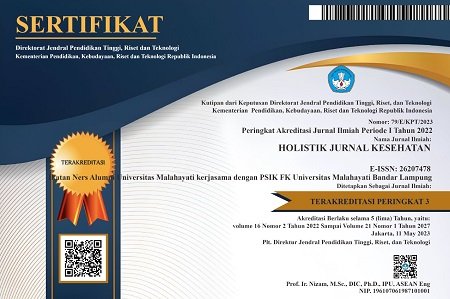Continuous intra-arterial blood gas monitoring for maintaining tissue perfusion during cardiopulmonary bypass (CPB) in cardiac surgery: A literature review
Abstract
Background: Heart surgery is the act of repairing or replacing part of the heart anatomy to restore the heart's function as a circulation pump. There are two categories of surgery, open heart surgery and closed heart surgery. Closed heart surgery does not require a cardiopulmonary bypass (CPB) machine. Meanwhile, open heart surgery will require support using a CPB machine to maintain circulation.
Purpose: To provide an overview and ideas from the results of a literature review regarding the importance of blood gas monitoring in heart surgical procedures that use a cardiopulmonary bypass (CPB) machine or device.
Method: Literature review research to analyze literature that has been selected from various sources to come to a conclusion on a new idea. The topics used are continuous blood gass and cardiopulmonary bypass. Journal searches via online databases include Scopus (n=310), Proquest (n=267), Sage journals (n=87), and Spinger link (n=20) so that the collected articles were 684. Researchers used a study selection guide PRISMA flow diagram for assessing article quality.
Results: Based on a review of 10 selected journals, it was found that blood gas examinations and assessments carried out continuously can provide better and more accurate values. This is very useful in maintaining or maintaining the quality of blood in the body's circulation during surgery. Blood gas monitoring that is generally assessed is PH, PaO2, PCO2, lactate, electrolyte values, arterial saturation and venous saturation. The obstacle experienced by the public is that continuous blood gas examination devices are expensive.
Conclusion: The use of blood gas monitoring and continuous blood gas measurements is very beneficial in improving the blood quality of patients undergoing heart surgery. Real time monitoring will be able to detect abnormal results and require immediate intervention.
Keywords: Cardiopulmonary Bypass; Cardiac Surgery; Continuous Blood Gass.
Pendahuluan: Tindakan pembedahan jantung adalah tindakan memperbaiki atau mengganti sebagian anatomi jantung untuk mengembalikan fungsi jantung sebagai pompa sirkulasi. Pelaksanaan pembedahan terdapat dua kategori, bedah jantung terbuka dan bedah jantung tertutup. Pada pembedahan jantung tertutup tidak memerlukan mesin cardiopulmonary bypass (CPB). Sementara bedah jantung terbuka akan memerlukan support penggunaan mesin CPB untuk mempertahankan sirkulasi tetap terjaga.
Tujuan: Untuk memberikan gambaran dan gagasan dari hasil literature review tentang pentingnya monitoring gas darah dalam prosedur pembedahan jantung yang menggunakan mesin atau alat cardiopulmonary bypass (CPB).
Metode: Penelitian literature review untuk menganalisis literatur-literatur yang telah dipilih dari berbagai sumber hingga menjadi sebuah satu kesimpulan ide baru. Topik yang digunakan yaitu continuous blood gass dan cardiopulmonary bypass. Penelusuran jurnal melalui online database antara lain, Scopus (n=310), Proquest (n=267), Sage journals (n=87), dan Spinger link (n=20) sehingga artikel yang terkumpul sebanyak 684. Peneliti menggunakan panduan penyeleksian studi PRISMA flow diagram untuk melakukan penilaian kualitas artikel.
Hasil: Berdasarkan review 10 jurnal pilihan, didapatkan bahwa pemeriksaan dan penilaian gas darah yang dilakukan secara continuous dapat memberikan nilai yang lebih baik dan akurat. Hal ini sangat bermanfaat dalam menjaga atau mempertahankan kualitas darah dalam sirkulasi tubuh selama pembedahan berlangsung. Monitoring gas darah yang umumnya dinilai adalah PH, PaO2, PCO2, laktat, nilai elektrolit, saturasi arteri, dan saturasi vena. Kendala yang dialami oleh masyarakat adalah device pemeriksaan gas darah secara continuous memiliki harga yang mahal.
Simpulan: Penggunaan monitoring gas darah dan pengukuran gas darah secara continuous sangat memberikan manfaat terhadap peningkatan kualitas darah pasien yang menjalani pembedahan jantung. Monitoring yang real time akan mampu mendeteksi hasil yang abnormal dan memerlukan intervensi segera.
Kata kunci: Bedah Jantung; Continuous Blood Gass; Cardiopulmonary Bypass.
Keywords
References
Al-Ghali, B. A., Alzubeidy, H. H., & Al-Dahan, Z. T. (2022). Non-Invasive Measurement of Arterial pH During Cardiopulmonary Bypass. International Journal of Online & Biomedical Engineering, 18(10).
Barry, A. E., Chaney, M. A., & London, M. J. (2015). Anesthetic management during cardiopulmonary bypass: a systematic review. Anesthesia & Analgesia, 120(4), 749-769.
Dunham, A. M., Grega, M. A., Brown IV, C. H., McKhann, G. M., Baumgartner, W. A., & Gottesman, R. F. (2017). Perioperative low arterial oxygenation is associated with increased stroke risk in cardiac surgery. Anesthesia & Analgesia, 125(1), 38-43.
Garrison, L., Riley, J. B., Wysocki, S., Souai, J., & Julick, H. (2022). Validation of transcutaneous carbon dioxide monitoring using an artificial lung during adult pulsatile cardiopulmonary bypass. The International Journal of Artificial Organs, 45(2), 155-161.
Gerritse, M., van Hoeven, M., & Overdevest, E. (2023). Comparison of venous pCO2 and exhaust pCO2 for calculating CO2 production during cardiopulmonary bypass. Perfusion, 38(4), 801-806.
Govender, K., Jani, V. P., & Cabrales, P. (2022). The disconnect between extracorporeal circulation and the microcirculation: A review. ASAIO journal, 68(7), 881-889.
Hessel, E. A. (2014, June). A brief history of cardiopulmonary bypass. In Seminars in cardiothoracic and vascular anesthesia (Vol. 18, No. 2, pp. 87-100). Sage CA: Los Angeles, CA: SAGE Publications.
Holst, K. A., Said, S. M., Nelson, T. J., Cannon, B. C., & Dearani, J. A. (2017). Current interventional and surgical management of congenital heart disease: specific focus on valvular disease and cardiac arrhythmias. Circulation research, 120(6), 1027-1044.
Lamperti, M., Jain, A., & Byrappa, V. (2020). Cardiac Surgery. In Echography and Doppler of the Brain (pp. 269-281). Cham: Springer International Publishing.
Martinez, G., & Whitbread, J. (2012). Cardiopulmonary bypass. Anaesthesia & Intensive Care Medicine, 13(10), 482-487.
Maruniak, S., Druzhyna, O., Loskutov, O., Todurov, B., & Swol, J. (2023). Being perfusionist during the war–cardiac surgery under missile strikes. Perfusion, 38(7), 1536-1538.
Matteucci, M., Ferrarese, S., Cantore, C., Cappabianca, G., Massimi, G., Mantovani, V., & Beghi, C. (2020). Hyperlactatemia during cardiopulmonary bypass: risk factors and impact on surgical results with a focus on the long-term outcome. Perfusion, 35(8), 756-762.
Mohammadhoseini, E., Safavi, E., Seifi, S., Seifirad, S., Firoozbakhsh, S., & Peiman, S. (2015). Effect of sample storage temperature and time delay on blood gases, bicarbonate and pH in human arterial blood samples. Iranian Red Crescent Medical Journal, 17(3).
Musat, A., Ouardirhi, Y., Marty, J. C., Benkhadran, S., David, M., & Girard, C. (2004). Significance of continuous blood gas monitoring in cardiac surgery with cardiopulmonary bypass. European journal of anaesthesiology, 21(12), 980-981.
Ottens, J., Tuble, S. C., Sanderson, A. J., Knight, J. L., & Baker, R. A. (2010). Improving cardiopulmonary bypass: does continuous blood gas monitoring have a role to play?. The Journal of extra-corporeal technology, 42(3), 191.
Patel, R., Solanki, A., Patel, H., Patel, J., Pandya, H., & Sharma, J. (2017). Monitoring microcirculatory blood flow during cardiopulmonary bypass in paediatric cardiac surgery patients as a predictor for anaerobic metabolism. Journal of Clinical and Diagnostic Research, 11(4), UC22–UC25.
Ranucci, M., Carboni, G., Cotza, M., & De Somer, F. (2017). Carbon dioxide production during cardiopulmonary bypass: pathophysiology, measure and clinical relevance. Perfusion, 32(1), 4-12.
Reagor, J. A., Gao, Z., & Tweddell, J. S. (2021). Spectrum Medical Quantum or Terumo CDI 500: Which Device Measures Hemoglobin and Oxygen Saturation Most Accurately When Compared to a Benchtop Blood Analyzer?. The Journal of Extra-corporeal Technology, 53(3), 181.
Svenmarker, S., Hannuksela, M., & Haney, M. (2018). A retrospective analysis of the mixed venous oxygen saturation as the target for systemic blood flow control during cardiopulmonary bypass. Perfusion, 33(6), 453-462.
Zhang, X., Zhang, W., Lou, H., Luo, C., Du, Q., Meng, Y., & Zhang, M. (2021). Risk factors for prolonged intensive care unit stays in patients after cardiac surgery with cardiopulmonary bypass: A retrospective observational study. International journal of nursing sciences, 8(4), 388-393.
DOI: https://doi.org/10.33024/hjk.v17i9.13025
Refbacks
- There are currently no refbacks.
Copyright (c) 2024 Holistik Jurnal Kesehatan

This work is licensed under a Creative Commons Attribution-NonCommercial 4.0 International License.














